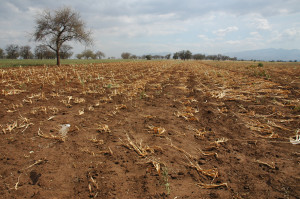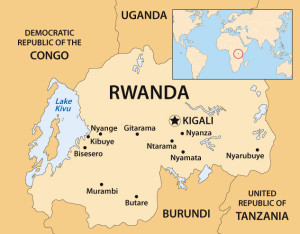by Aura Lawson
La Niña has persisted longer than expected this year, and with it comes agricultural uncertainty for many countries across the globe. Rwanda is no exception.
Anthony Twahirwa, head of Rwanda’s Meteorological Center, explains that their forecasting agency expected decreased rainfall as a result of La Niña, or abnormally cool waters in the eastern Pacific, but that they didn’t expect the pattern to persist for as long as it has.
“Normally, the country should have started receiving rains at a regular interval from March this year but we are still waiting for it to start,” explains Twahirwa. With this same pattern happening several years in a row, the problem has been exacerbated and it is expected that the Rwandan government will soon have to start tapping into its emergency food stores.
A big dilemma for Rwandan farmers has been whether or not to plant seeds at all this year. If seeds are not planted, it is certain that there will be no food come harvest time at the end of the summer. Conversely, if seeds are indeed planted, there is a high chance of there not being sufficient moisture for the seeds to germinate this year, and a significant amount of money will have been lost in the planting that could have been avoided. Under either scenario, this year’s harvest will be ruined and the country will have to adopt widespread drought mitigation strategies.
This lack of rainfall comes at a time when temperatures are higher than ever in Rwanda. The last decade was the warmest on record, with 2010 being the hottest year on record. Average maximum temperatures were nearly three degrees warmer between 2001 and 2010 than they were from 1990 to 2000.

Stunted crops in neighboring Tanzania, which has likewise been experiencing record heat and anomalous drought. Image reproduced from Michigan State University.
There are several ways that this scenario could play out in the future. The world could cooperate and find efficient ways to slow global warming by decreasing carbon and methane emissions, preventing further global warming that might contribute to worse droughts. Climate forecasting could get better, which would allow forecasters at Rwanda’s Meteorological Center and across the globe to be prepared for prolonged La Niñas and decreased rains, increasing the chance that farmers, the agricultural sector, and the country’s emergency management service will be better prepared for such a disaster. Or, nothing happens: the world will be unable to agree upon measures to prevent further climate change; accurate climate forecasting will be nearly impossible due to drastic increases in greenhouse gases without precedent; and humanity will plow ever forward toward a potentially disastrous future.
For now, Rwandans will continue to pray for rain, and meteorologists and climatologists will continue to collect weather data to improve forecasts for the region. Forecasts will better empower the peoples of Rwanda to plan for dry times.
References
Agutamba, Kenneth. “Rwanda: Experts Predict Long Droughts, Call to Increase Food Storage.” AllAfrica. 9 April 2012. 23 April 2012. <http://allafrica.com/stories/201204090542.html>
National Oceanic and Atmospheric Administration. “NOAA’s El Niño Page.” NOAA. 23 April 2012. <http://www.elnino.noaa.gov/>


Comments are closed.